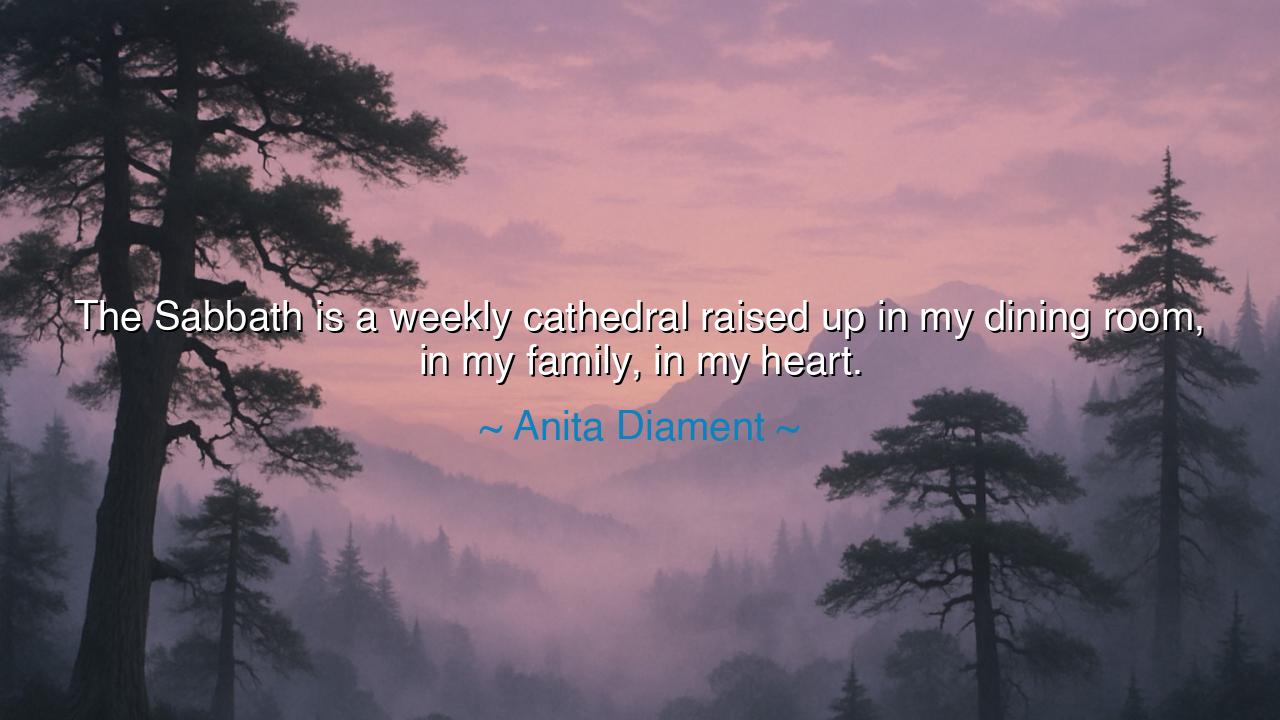
The Sabbath is a weekly cathedral raised up in my dining room, in
The Sabbath is a weekly cathedral raised up in my dining room, in my family, in my heart.






“The Sabbath is a weekly cathedral raised up in my dining room, in my family, in my heart.” Thus spoke Anita Diamant, a writer whose words carry the spirit of both reverence and renewal. In this single, luminous sentence, she unveils the ancient truth that the Sabbath—the day of rest, of holiness, of stillness—is not merely a commandment carved in stone, nor a ritual confined to temples of marble, but a living sanctuary built anew each week within the heart and home. Her vision transforms the sacred from a distant place to a personal experience. The cathedral she speaks of is not raised by hands but by love; its pillars are not stone, but family; its altar is the table where bread is broken, and peace dwells.
When Diamant calls the Sabbath a weekly cathedral, she reminds us that holiness does not depend upon grand architecture or solemn ceremony. The true sanctuary is built from intention—from the human desire to pause, to reflect, and to honor the divine rhythm that beats through creation. Just as the ancients gathered in temples to worship, so too does the modern soul build its own sacred space each week, wherever gratitude and rest are found. The dining room, that simple place of gathering and nourishment, becomes a holy hall when the Sabbath enters. And when it enters the heart, even the ordinary is transfigured into the sacred.
The origin of this understanding reaches back to the first Sabbath—the seventh day of creation—when, as the Scriptures say, God rested. Yet this rest was not idleness; it was a pause of perfection, a divine breath taken in contemplation of all that had been made. To keep the Sabbath is to participate in that same act of sanctified rest—to cease striving and simply be. Anita Diamant, as a storyteller of Jewish heritage, draws from this deep well of tradition. For in Judaism, the Sabbath is called the Queen, the Bride of Time—a day that visits each week to remind mankind of eternity. In her words, Diamant rekindles this ancient truth, showing that even in modern life, surrounded by noise and haste, the Sabbath can still enter, quietly and powerfully, transforming the home into a cathedral of peace.
Consider the story of Abraham Joshua Heschel, the great rabbi and philosopher who once wrote, “The Sabbath is a sanctuary in time.” During his years of teaching and prayer, Heschel found that true holiness could not be contained in stone walls alone. He spoke of time itself as the temple of God, of the Sabbath as a realm of spirit where humanity is freed from the tyranny of labor and possession. On the Sabbath, he said, man ceases to be a slave—to work, to ambition, to anxiety—and becomes once more a soul in harmony with creation. Heschel’s life embodied the same truth Diamant expressed: that holiness is not distant, but near; not abstract, but lived. Each meal shared in love, each candle lit in gratitude, each breath taken in peace—these are the stones of the cathedral within.
The beauty of Diamant’s imagery lies in its intimacy. The divine is not high above the clouds; it is at the table with us. When the Sabbath arrives, it enters not through a church door, but through the front door of the home. The laughter of children, the scent of bread, the gentle silence after prayer—these become the hymns and incense of a spiritual life. In a world that glorifies speed and productivity, the Sabbath is rebellion in the form of rest. It is a holy reminder that being is more sacred than doing, and that love, shared simply and quietly, is the truest form of worship.
The lesson is both profound and practical: build your own cathedral each week. It need not be adorned with gold or guarded by priests. It is made by turning off the noise, setting aside the burdens of the world, and returning to what is eternal. Gather with those you love, share the bread of kindness, light the candles of gratitude, and rest. Let your heart be still long enough for the sacred to enter. For the Sabbath is not a rule but a gift, not a duty but a renewal of the soul.
So, my child of restless days, remember this: the world will always demand your labor, but the Sabbath asks only for your presence. Each week, raise your cathedral not with your hands, but with your spirit. Build it in your family, where love is your prayer. Build it in your heart, where gratitude is your offering. When you do, you will discover that holiness is not far away—it has always been within you, waiting for your rest, waiting for your reverence. For truly, as Anita Diamant wrote, “The Sabbath is a weekly cathedral raised up in my dining room, in my family, in my heart.”






AAdministratorAdministrator
Welcome, honored guests. Please leave a comment, we will respond soon